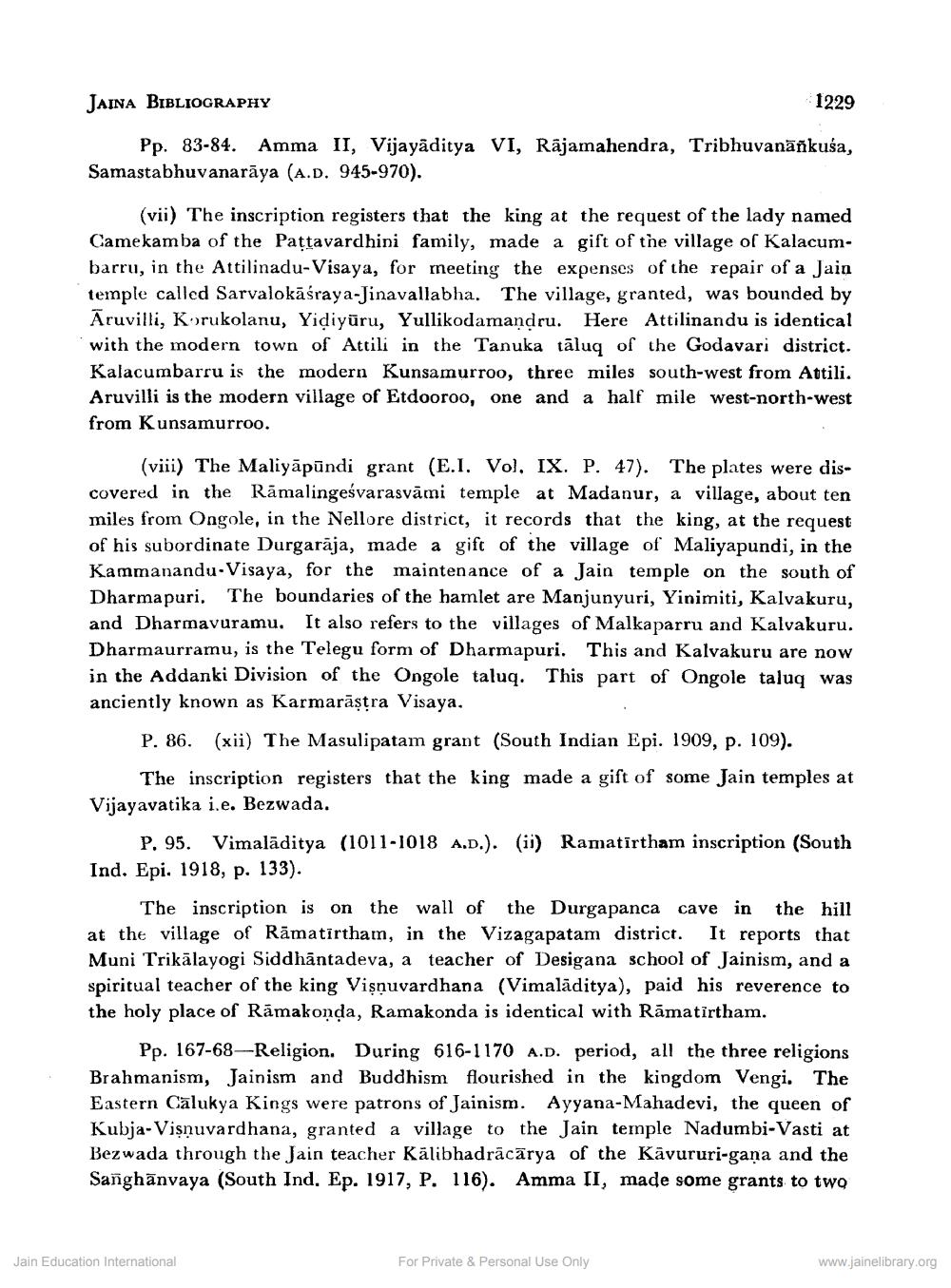________________
JAINA BIBLIOGRAPHY
1229
Pp. 83-84. Amma II, Vijayaditya VI, Rājamahendra, Tribhuvanāñkusa, Samastabhuvanarāya (A.D. 945-970).
(vii) The inscription registers that the king at the request of the lady named Camekamba of the Pattavardhini family, made a gift of the village of Kalacumbarru, in the Attilinadu-Visaya, for meeting the expenses of the repair of a Jain temple called Sarvalokāśraya-Jinavallabha. The village, granted, was bounded by Aruvilli, Kuyrukolanu, Yidiyūru, Yullikodamandru. Here Attilinandu is identical with the modern town of Attili in the Tanuka tāluq of the Godavari district. Kalacumbarru is the modern Kunsamurroo, three miles south-west from Attili. Aruvilli is the modern village of Etdooroo, one and a half mile west-north-west from Kunsamurroo.
(viii) The Maliyāpūndi grant (E.I. Vol. IX. P. 47). The plates were discovered in the Rāmalingeśvarasvāmi temple at Madanur, a village, about ten miles from Ongole, in the Nellore district, it records that the king, at the request of his subordinate Durgarāja, made a gift of the village of Maliyapundi, in the Kammanandu-Visaya, for the maintenance of a Jain temple on the south of Dharmapuri. The boundaries of the hamlet are Manjunyuri, Yinimiti, Kalvakuru, and Dharmavuramu. It also refers to the villages of Malkaparru and Kalvakuru. Dharmaurramu, is the Telegu form of Dharmapuri. This and Kalvakuru are now in the Addanki Division of the Ongole taluq. This part of Ongole taluq was anciently known as Karmarāstra Visaya.
P. 86.(xii) The Masulipatam grant (South Indian Epi. 1909, p. 109).
The inscription registers that the king made a gift of some Jain temples at Vijayavatika i.e. Bezwada.
P. 95. Vimalāditya (1011-1018 A.D.). (ii) Ramatirtham inscription (South Ind. Epi. 1918, p. 133).
The inscription is on the wall of the Durgapanca cave in the hill at the village of Rāmatirtham, in the Vizagapatam district. It reports that Muni Trikālayogi Siddhāntadeva, a teacher of Desigana school of Jainism, and a spiritual teacher of the king Vişnuvardhana (Vimalāditya), paid his reverence to the holy place of Rāmakonda, Ramakonda is identical with Rāmatirtham.
Pp. 167-68-Religion. During 616-1170 A.D. period, all the three religions Brahmanism, Jainism and Buddhism flourished in the kingdom Vengi. The Eastern Calukya Kings were patrons of Jainism. Ayyana-Mahadevi, the queen of Kubja-Vişnuvardhana, granted a village to the Jain temple Nadumbi-Vasti at Bezwada through the Jain teacher Kalibhadrācārya of the Kāvururi-gana and the Sanghānvaya (South Ind. Ep. 1917, P. 116). Amma II, made some grants to two
Jain Education International
For Private & Personal Use Only
www.jainelibrary.org




